
Have you noticed that Google is constantly making algorithm changes? And when they do, they rarely tell you the change they’ve made.
They tend to keep it a bit vague, like this…
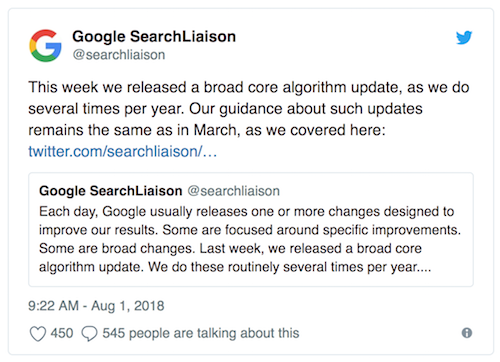
So, do you want to know how got around this algorithm update?
Well, before I tell you how, there are a few things you need to know.
How Google works
Can you guess how many factors there are in Google’s algorithm?
SEO is complicated. If Google made SEO easy you would see product and service pages rank at the top of every Google search instead of content-rich pages.
That means it would be easier for you to rank and make money, which would cause fewer companies to spend money on Google Ads.
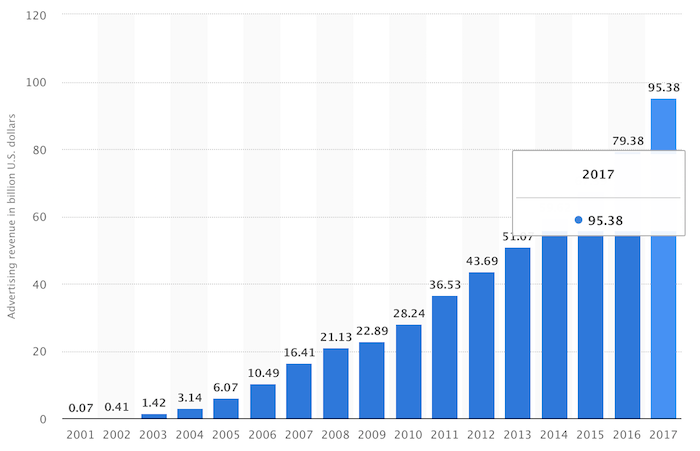
Just look at the image above, Google generated over 95 billion dollars in ad revenue. That’s a ridiculous amount of money!
Now, Google isn’t just focusing on placing content-rich sites high up in the search results because they care about ad revenue, they do this because that’s what you want.
See, Google’s goal is to provide the best experience for you.
If you as a user wanted to see product and service related pages in the top of organic results, then that’s what they would start doing.
By providing you with the best user experience, this causes you to keep coming back to Google, which allows them to monetize through ads.
If they didn’t focus on user experience and making you happy, Google wouldn’t be the most popular search engine. It would be Bing or some other search engine.
So, when Google makes an algorithm change they are doing this because they’ve learned how to provide a better experience for you.
They aren’t making these changes because they want to screw up your rankings or ruin your business.
Google isn’t perfect
Similar to any other business, Google isn’t perfect. They make mistakes (we all do), and sometimes the changes they make may not provide the best experience for you.
When they may roll out changes, they may learn some adjustments didn’t work out the way they wanted, which causes them to constantly go back and make tweaks.
This is why you see search traffic fluctuations. Just look at my search traffic for all of 2017:
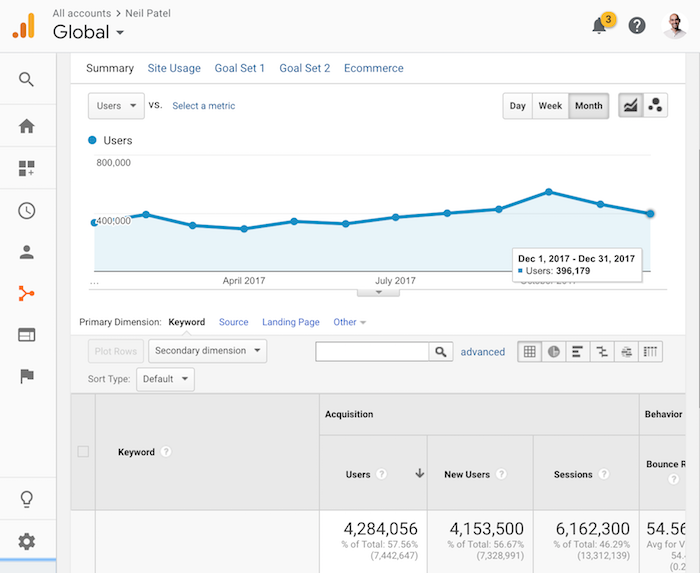
When looking at the graph above, you may notice that I generated 6,162,300 visits from search of which 4,284,056 were unique.
And if you look even closer, you’ll see that 2017 started off really well. February was a great month even though it has fewer days.
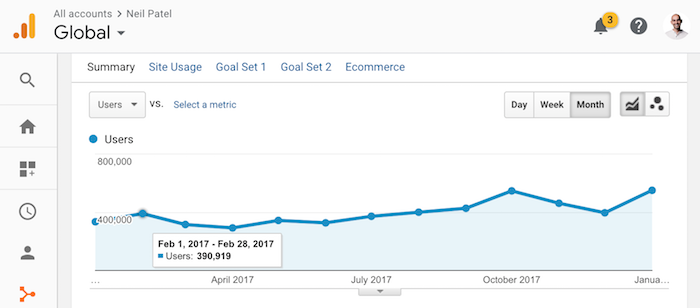
In February, I generated 390,919 visits from search but then in March, my traffic went down. And then in April, I saw another drop.
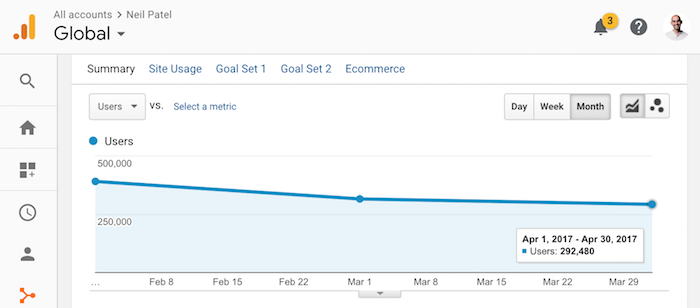
The drop may not seem that big when you look at the graph, but April’s search traffic came in at 292,480. That’s a 25.18% drop in search traffic when you compare it to February.
Ouch!
I didn’t make any major changes to my website that would have caused the drop and there isn’t seasonality around that time…
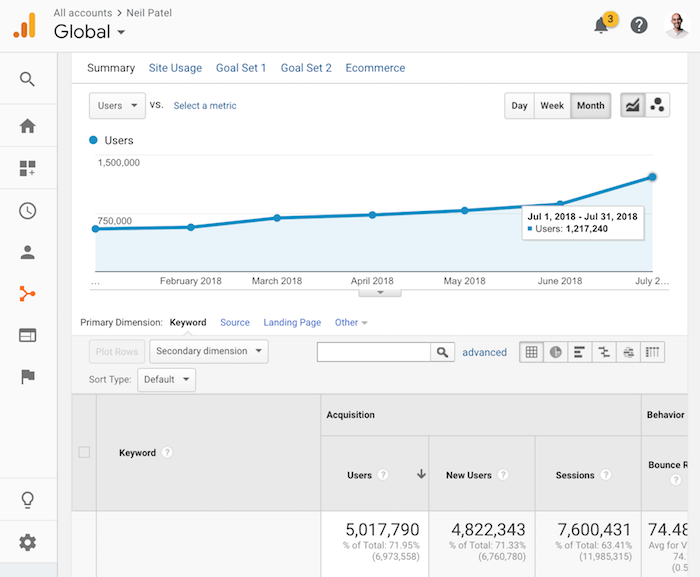
As you can see from the screenshot above, my 2018 search traffic shows a trend of going up and to the right (that throws the seasonality theory out the door).
And honestly, I don’t know if Google made any algorithm changes during that time in 2017 because I don’t pay attention to them (I’ll get into this a bit later).
In other words, your traffic is going to fluctuate, and that is ok. But when you look at your search traffic, as long as it is going up and to the right year after year, you are fine.
2017 was a rough year for me as my search traffic didn’t start going up again until August. I wasn’t doing anything different, it’s just the way the cookie crumbles.
So why don’t I pay attention to Google algorithm updates?
I mentioned this above, and I know it may seem shocking. Yes, I do read up on them every once in a while, but I don’t need Google to tell me about where they are heading with their algorithm.
You, the user, tell me this.
So instead, I focus on you. If I do what’s best for you, eventually my site will rank higher.
Sure, in the short run my rankings may drop, but I know if I focus on you (the user) it will give me the highest probability of ranking in the long run.
Just look at my search traffic for the first 7 months of 2018:

I’ve already beat my 2017 numbers!
5,017,790 is the number of unique search visitors that have come to NeilPatel.com in the first 7 months of 2018. The count for all of 2017 was 4,284,056.
That’s a huge difference.
As long as I do what’s best for you I know that my total traffic should go up and to the right.
If you look at my traffic from when I started to blog on NeilPatel.com (August 2014) to now, you’ll see that my traffic goes up and down each month, but the overall graph is up and to the right.
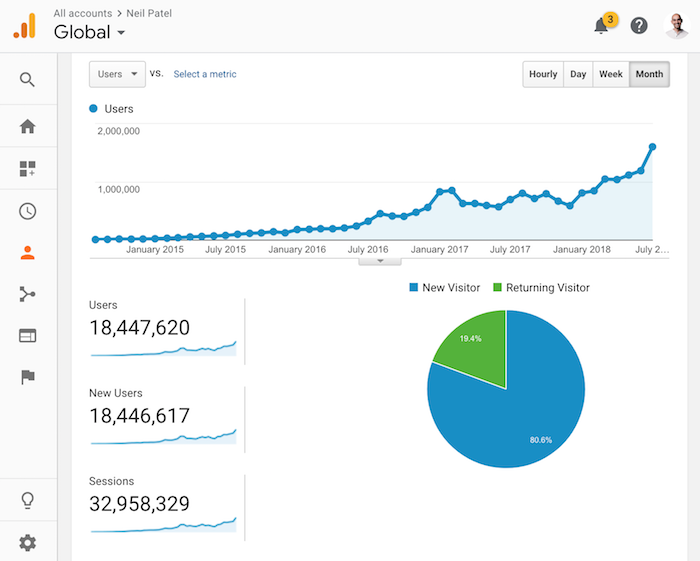
So, are you saying that you don’t care about SEO?
No, I still care about SEO and I practice it daily.
I just don’t stress out about every Google algorithm update because it isn’t in my control.
This doesn’t mean I ignore the advice Google gives. For example, when they announced that they were going to create a mobile-first index, I made sure I optimized my site for mobile.
But trying to read into every Google update and making assumptions on what I should do next is like playing a game of cat and mouse.
It’s time consuming, exhausting and inefficient. You are better off spending your time making your website better for your users.
Like I always say: Succeeding with digital marketing is a long-term game. Focus on the long term.
So how do you ensure long-term success?
I already showed you that my traffic goes up and to the right over time.
Here’s my secret to ensure that Google loves you in the long run.
Please, please, please note that some of the tactics I’m about to share with you may reduce your traffic in the short run, but you will be better off in the long run.
Strategy #1: Prune and crop
A lot of marketers discuss how pruning and cropping your content can triple your traffic.
If you aren’t familiar with the process, it’s as simple as updating your mediocre content and make it amazing. And as for your irrelevant content that is no longer valid, you would delete them and 301 redirect those URLs.
I’ve done this multiple times on dozens of sites. I have friends who have done it as well. We all see one major trend from doing this… traffic usually drops.
Even if those pages that you are pruning and cropping barely get any Google traffic, you’ll still typically see a drop in traffic.
The only time you’ll see an increase is if your content was so bad, such as deleting short blog posts that are filled with duplicate content.
Even if your blog is new, you should consider pruning and cropping once a year. It will ensure that you are updating your content, thus providing the best experience for your users.
Here’s the process I use to prune and crop (use Excel or Google Sheets to do this):
- Create a list of all of the URLs on your website – using Screaming Frog, I crawl my website so I can get a full list of every URL, title tag, meta description, number of inlinks (number of internal links pointing to that URL), and the word count.
- Add in traffic per page – I then log into my Google Analytics account and list out how much traffic each URL is generating.
- And then I add in backlinks per page – I put each URL into Ahrefs to see how many backlinks each URL has.
- Lastly, add in social shares per URL – using a tool like SharedCount you can get the total social shares per URL.
You should have a spreadsheet that looks something like this:
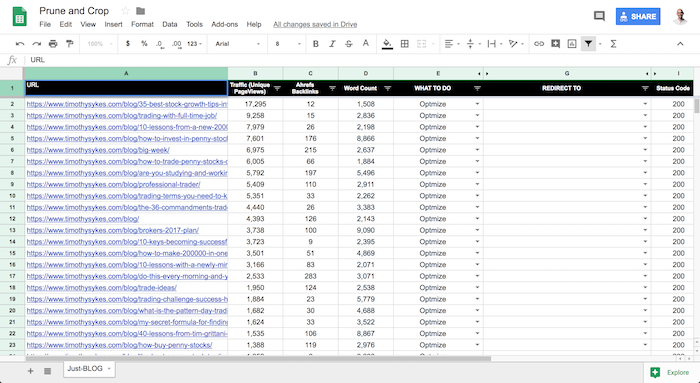
I know the image may be hard to see, so here is a sample.
Some of the data is junk and inaccurate in the sample. Also keep in mind that I am missing some data, such as meta description and social shares (I still haven’t completed this spreadsheet).
The reason I shared the sheet with you is that you’ll notice I added a few additional columns such as “what to do” and “redirect to.”
The 4 options I have under “what to do” are: optimize, delete, redirect, and nothing.
Once your spreadsheet is complete, you need to manually review each URL and select one of the 4 options above. Here’s when to select each one:
- Optimize – if the page is popular, it has backlinks, traffic, and social shares, consider optimizing it. This could involve adding more internal links to the page, updating the content, or even optimizing the on-page code.
- Delete – if the page has little to no search traffic, backlinks, social shares, and doesn’t provide any value to the user, consider deleting it. When doing so you will want to update any internal links that were pointing to this URL and then, of course, take this URL and 301 redirect it to the most relevant page.
- Redirect – if the page is very similar to another page on your site, consider merging the content and 301 redirecting the URL to the similar one. You’ll want to take the least popular version and redirect it to the popular one. A good example of this is if you have two blog posts about social media marketing tools, you’ll want to combine the content, create a 301 redirect, and adjust the internal links to point to the final URL.
- Nothing – if the page is fine and there is nothing wrong with it, do nothing.
Strategy #2: Expand internationally
There are over 7 billion people in this world, and most of them don’t speak English.
Yes, Google is a difficult beast to conquer, but it isn’t in non-English speaking countries. Whether it is France, Germany, Brazil, or any other country where English isn’t the main language… it’s much easier to get to the top of Google.
Sure, the search volume may not be as high in countries like Brazil, but because the competition is low, you can dominate fast.
Here are the most widely spoken languages in the world:

And here is the GDP per country:
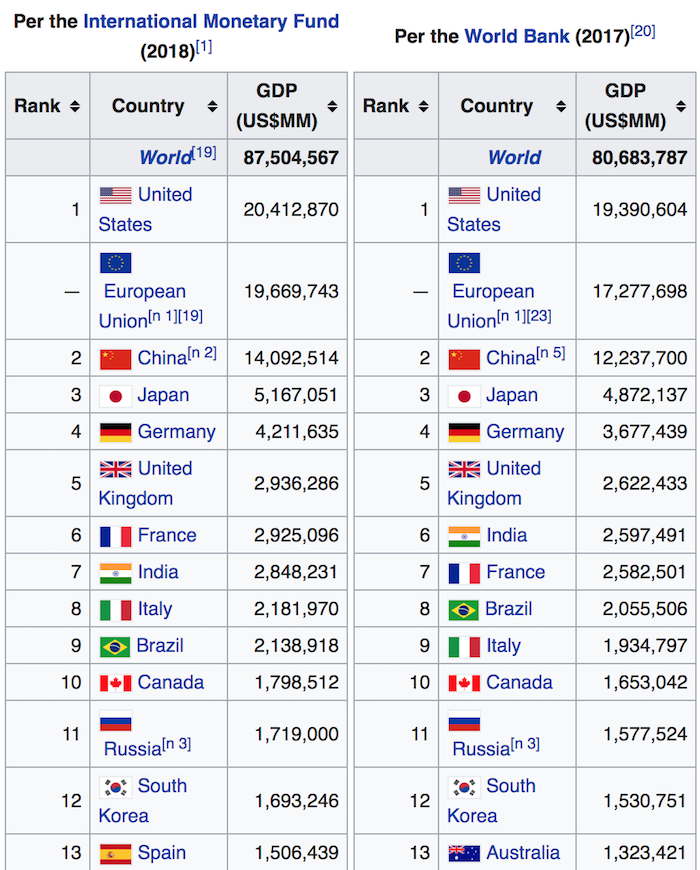
And here is the population per country:
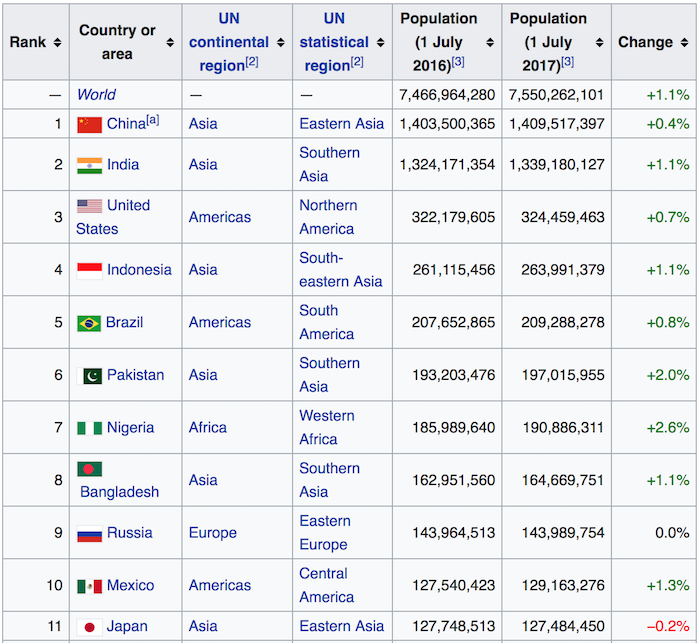
The best countries to go after when it comes to SEO are the ones that have a high GDP and a large population.
Going international has done wonders for my traffic.
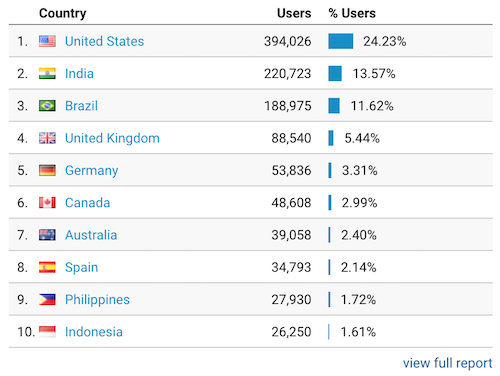
In the last 31 days, the United States only made up 24.23% of my traffic. If you want to grow your global search rankings, just follow the steps in this blog post.
It goes in-depth on international expansion and the lessons I learned from a Google employee.
The cool part about international SEO is that it also creates a better user experience for your users as they will be able to read your content in their native language.
Strategy #3: Fix broken links, images, and media files
Let me ask you a question…
What if you were reading this post and half of the links you clicked on where broken? Especially the links that were supposed to teach you the steps you needed to take to grow your traffic?
You would be upset, right?
I know I would.
And to make matters worse, what if half of the images in this post were also broken?
Do you see how that would provide a terrible experience?
Well of course you do. That’s why you need to fix broken links, broken images, and broken media files on your website.
You don’t have to do this every month, but you should do this once a quarter. You can even use tools like Broken Link Check to make things a bit easier for you.
Strategy #4: Fix errors within Google Search Console
Even if you don’t log into Google Search Console, they will email you when there is a spike in errors.
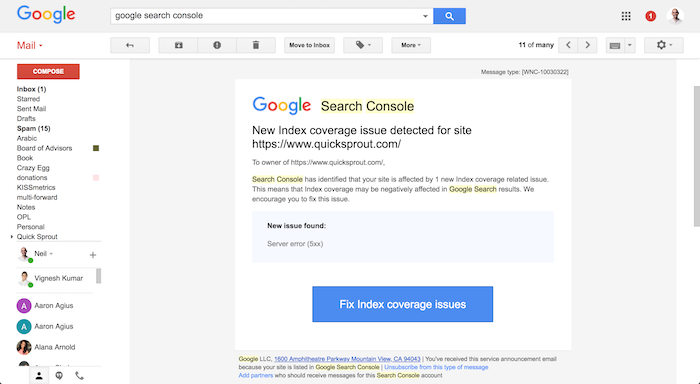
When you get these emails, make sure you fix them. If you don’t know how to fix them, find a developer on Upwork to help you fix them.
And once you fix them, Google will email you when they acknowledge the fix.
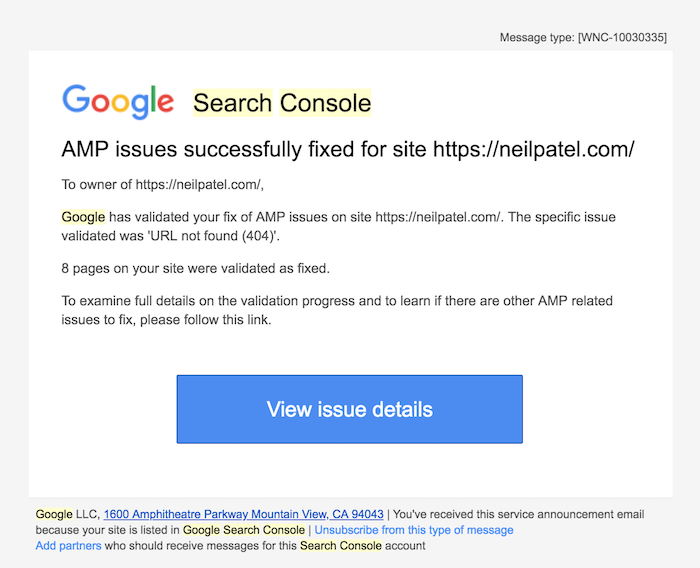
It’s really important to fix your Search Console errors. I know this is an obvious tip, but most people don’t do it.
This one little thing will reduce your search traffic fluctuations. You will never be able to stop the fluctuations, but this will help reduce them.
Strategy #5: Build a brand
Do you know what the future of SEO is?
It’s brands!
The websites that dominate Google may not have the most backlinks, but they tend to have big brands.
People trust brands, which means Google trusts brands.
When you want to buy running shoes, what brand comes to mind?
I bet it’s Nike.
When you want a credit card, what brand are you going to choose?
Probably Visa, Mastercard, or American Express.
You don’t always Google for a product or service, in many cases you just go to the brands you are familiar with.
Not only does building a brand help with Google traffic, but it helps diversify your traffic sources so you aren’t just relying on Google search.
If you don’t believe that branding is valuable, check out this blog post. It breaks down how I grew my traffic from 240,839 to 454,382 visitors in one month (before exploding into seven digits) all because of branding.
It even breaks down the steps you can follow to build up a brand for your company.
It works so well, that I was even able to grow the brand value of my free marketing tool, Ubersuggest.
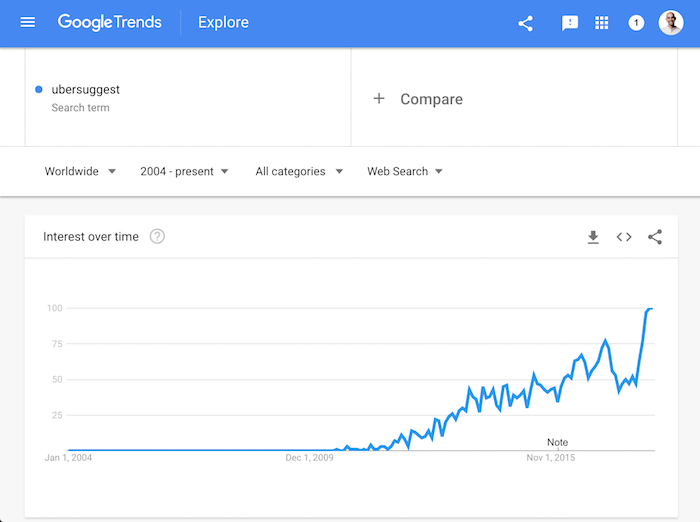
Strategy #6: Keeping a close eye on my competition
You don’t have to be 10 times better than your competition to beat them. Just being a little bit better can do wonders.
Now, if it was up to me, I would tell you to be 10 times better, but I know that can be expensive and is unrealistic in most cases.
If you haven’t, subscribe to your competition’s website.
From joining their email list to following them on their social profiles to even testing out their products/services.
Do whatever you can to stay up to date on your competition. If you can beat them, even by a little bit, people will prefer your site over their site in the long run. This will help you rank higher and get more traffic (and sales!).
And as I mentioned above, being 10 times better is a bit crazy, but usually when you do that your competition won’t copy you.
When you beat them by a little bit, that’s where you will find yourself battling back and forth when it comes to winning over people (and Google).
Conclusion
If you want to get around Google’s algorithm changes, you have to stay ahead by focusing on your users. Do what’s best for them and you won’t have to deal with Google’s ever-changing algorithm.
If you don’t follow the tips above, you’ll save time in the short run, but you’ll find yourself playing a game of cat and mouse in the long run. That just seems exhausting to me.
I don’t pay too much attention to algorithm updates and you shouldn’t either. Instead, focus on providing an amazing user experience. That’s what will cause you to win in the long run.
Now, there will be times where your traffic will drop, but don’t freak out. You can eventually come out on top by focusing on your users.
And if you got to the top of Google by optimizing your site for search engines instead of people, you will eventually get caught up in an update. When that happens, check out this algorithm tracker as it will help you determine what’s changed, what you did wrong, and what you need to fix.
It’s just tedious, which is why I get ahead, focus on the user, so that way I don’t have to focus on Google as much.
So, do you pay attention to every algorithm update Google does?
The post How to Get Around Google’s Latest Algorithm Change appeared first on Neil Patel.
from Blog – Neil Patel https://ift.tt/2LXy2Gb

No comments:
Post a Comment